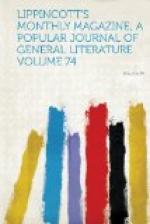III.—INTERNAL DIVISIONS.
Nothing is more logical than religious creeds—nothing more rigorously consequent in its deductions than the theological mind. Religious thought has an unimpeded course in the twilight of mystery where it takes its airy flight, and no material facts avail to check it or divert it from the chosen path. The innate logic of the Russian mind adds force to the kindred theological quality in its influence upon the Raskol, for the inhabitant of Greater Russia is distinguished for his logical consecutiveness and his acceptance of the extremest consequences of a position. This is partly the cause of the multiplicity and growth of the strange doctrines prevalent among them; and while this disposition frequently lands the schism in the most grotesque of absurdities, it gives a remarkable unity and regularity to even its apparent divergencies and variations. Irregularity and the play of chance have as little real place in this spiritual phenomenon as in one belonging to the region of physics; and a knowledge of the terminus a quo would have suggested its complications as well as the point ultimately reached. One is now and then tempted to look upon the various sects as utterly chaotic, but it is not difficult to trace the general course of their natural evolution.
A less robust faith might easily have been cast down by the obstacle which confronted the schism at the outset. The revolt aimed at maintaining the ritual, yet the lack of priests to officiate necessitated its abandonment. The defenders of the old faith found themselves, at the first step, deprived of the means of practicing its rites. A single bishop, Paul of Kolomna, had held out for the ancient books at the time of Nikon’s reform, but he had been imprisoned, and perhaps put to death: at all events, he died without consecrating a bishop, and the Raskol was consequently left without an episcopate or a priesthood. Now, Oriental orthodoxy is not simply doctrinal in its character, but, as M. A. Reville has remarked of Catholicism, “is, above all, a method of establishing communication between man and God by the medium of an organized priesthood, whose successive members transmit uninterruptedly the divine powers which they hold from Christ;” and the death of Paul of Kolomna snapped the chain uniting the Old Believers with Christ, for ever depriving the schism of the powers conferred by Christ on the apostles and essential to the continuance of the priesthood and the Church.
The Raskol, so to speak, was stillborn. Unless they retraced their steps, there were but two paths to take—either to admit priests consecrated by a Church they had condemned, or to dispense with the clergy, who alone could celebrate the rites in defence of which they had revolted. There was little to choose between the two self-contradictory courses, and each had its partisans. This first check split the schism into two groups, whose hostility




